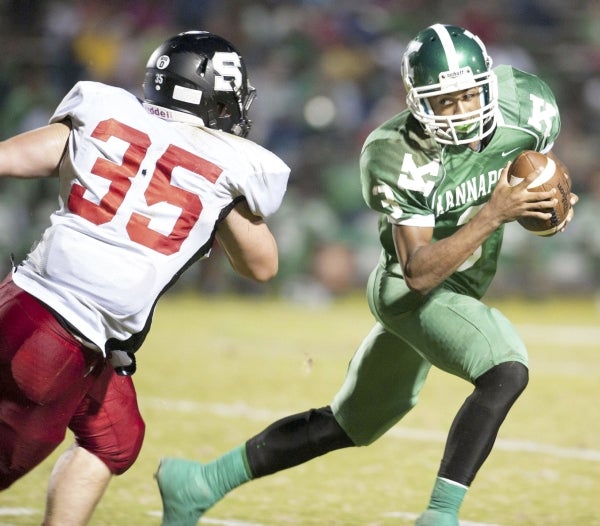Larry Efird: The presence of wonder
Published 12:00 am Sunday, January 24, 2016

- Wonders quarterback Damon Johnson (3) makes a move to avoid South Rowan’s Alex Parham (35) during a 2014vgame at Kannapolis. The Wonders won, 51-7. Jon Lakey/Salisbury Post
High school nicknames and mascots are important for many reasons. Whether they be Hornets or Raiders — Falcons or Mustangs — War Eagles, Cougars, or Cavaliers, who can deny the impact a simple symbol has on unifying an entire school?
I happen to work at a school whose moniker is a Wonder. Where that name came from is debatable at best, but all agree it’s hard to define. Hence, the perpetual question from opposing fans at almost every game: “What’s a Wonder?”
People asked that question when I was in high school too, shortly after the Medieval Period, so I’m not at all surprised that they are still asking it, even some of my own students, I might add. I begin by telling them a Wonder is abstract, so there’s no concrete symbol associated with a Wonder, other than the Seven Wonders of the Ancient World, a superhero or two, and a host of Bible verses which mention things such as “signs and wonders.” There are also wonders of nature such as four-leaf clovers and fireflies, but sometimes they still wonder what a Wonder really is.
The dictionary is a practical place to start when perplexed by the connotation or denotation of a word. Most lexicographers define a wonder as an “act of awe or a miracle.” Furthermore, the ancient philosopher Socrates once said, “All wisdom begins in wonder.” On his recommendation alone, we see the word wonder denotes something special.
The well known American children’s author E.B. White has said, “Always be on the lookout for the presence of wonder.” What a great attitude for life and especially for teachers! We surely see enough negative examples of behavior and educational deficiencies in our classes, but we also get to see the presence of wonder, that magic moment when a kid finally “gets it,” and we know then that we will be able to go home and sleep at night, not worrying that we have lost the art of teaching because no one seems to be “getting it” any more.
Perhaps we witness the presence of wonder when a new student enrolls in our school and we see two kids, totally unprompted, invite him to sit with them at lunch. Or maybe it’s when we get a note from a former student thanking us for how much we did for her, not knowing the impact we actually had on her life because she really never did anything in class to be noticed, good or bad.
Many of my students still say, “Yes sir” or “No sir” because their parents trained them to do so. But a year ago, I overheard a 10th grade girl whom I had reprimanded during the preceding class, tell those around her, “I’m not going to let the elderly disrespect me!” I wasn’t sure what she had said, but fortunately, she said it again, so there was no mistake. Coming only a few months before my 60th birthday, I saw the irony and the reality in her comment, and rather than get angry, I actually laughed. That qualified as a presence of wonder moment too, because of my response. Her comment actually cheered me up. To be honest, I was glad she knew what the word elderly meant and that she used it correctly in a sentence!
Teachers need to be looking for and sharing presence of wonder moments with each other. We rarely get any good news from our government officials because they don’t see the presence of wonder moments that we see. Unfortunately, they only focus on other issues. When I choose to focus on test scores and measure my effectiveness as a teacher by artificial standards, I sink to a presence of woe moment. There’s not much wonder looking at test scores or state report cards.
Who doesn’t want to experience more presence of wonder moments? We need to remember to look for the four leaf clovers and fireflies among our students. By doing so, hopefully we can celebrate the presence of wonder that is surely all around us by remembering to focus on the truly important things. Then, we won’t have to ask, “What’s a Wonder?” because, luckily, we’ll be surrounded by them.
Larry Efird teaches at A.L. Brown High School in Kannapolis, home of the Wonders.

